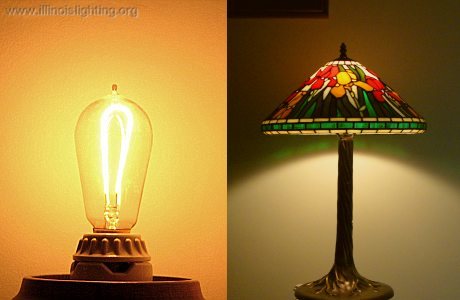Working toward legislation to curb light pollution in Illinois.
|
Fixtures are often specified for new or replacement installations by architects or committees who will look at a catalog and pick a design which will look good in the daytime, without considering the energy cost of running them night after night, year after year, or the impact (good or bad) which nighttime lighting can have on an installation or its neighborhood. Illuminating An AreaAny outdoor illumination should serve a purpose. The most common one is to illuminate an area where people must see things after dark to perform some type of activity; this may be to operate vehicles, walk, play sports, or shop. Responsibly engineering a lighting installation involves determining what light level is needed for the activity, and designing a set of fixtures to deliver only that amount, only to the area which needs illumination. The most efficient way to illuminate an area lighting is usually to install fixtures overhead, shining their light downward. Most standard types of light fixture will best illuminate the area under the fixture, with the light level tapering off the further one moves along the ground away from the spot under the light; in other words, the fixture creates a cone of good illumination under it. Fixture spacing is determined by the quality of lighting needed for the activity. Pedestrian and vehicular movement can often be served by having the light cones of adjacent fixtures just intersect, as in the top row of the illustration below; high light level activities such as automobile sales lots (during business hours) may need closer light spacing for more uniform, multi-directional illumination.  Two rows of lights; the top one with the fixtures spaced so the fully illuminated zones meet, and the lower one with the zones overlapping, so each spot is illuminated from multiple directions.LIGHT LEVELS: The amount of lighting an area receives can be measured in several ways. The most common system is to measure the amount of light falling on a given surface area; the primary units used for this are foot-candles and lux. Different nocturnal activities require different levels of lighting to be accomplished safely and successfully. As noted above, proper engineering of outdoor lighting installations includes determining the appropriate levels, and sizing and spacing fixtures to achieve levels within the appropriate range over the area to be illuminated (and to not spill illumination outside of that area). Activities such as navigating through a parking lot may take as little as .25 foot-candles; walking up a stairway may need illumination in the 1-5 foot-candle range, and safely fueling a vehicle 10 foot-candles. HOURS OF OPERATION:
GLARE AND LIGHT TRESPASS: The human eye is capable of adapting to see over a wide range of lighting conditions, from intensely sunlit day to faintly moonlit night. When the eye is adapted to lower lighting conditions, such as outside after dark, and a distinct light source is presented which "overloads" it with too high a light level, glare occurs. We end up neither being able to see the bright light nor the formerly visible nighttime scene around it well.

"Light trespass" is the term used to describe artificial light which shines from an area of intended illumination to adjacent areas. If your neighbors' lights shine brightly into your yard and windows, that is light trespass. If the streetlight outside keeps you awake at night, that is light trespass. If you look up in the clear sky at night, and see no stars, only the glow of many lights making your sky bright, that is light trespass (although this last variety also goes by the commonly used name of "light pollution"). |
Return to Page Top |
|||
light pollution Illinois Chicago Cook County DuPage County Will County Springfield energy enviromnent global warming anti light pollution legislation lighting ordinances |
|||


 Operating exterior (and interior) lighting outside of the hours when it is actually needed is a source of tremendous energy waste in our state. Timers or
Operating exterior (and interior) lighting outside of the hours when it is actually needed is a source of tremendous energy waste in our state. Timers or  Soon after the invention of the electric lamp came the development of the lampshade; people found that having a glaring light bulb in view actually made it harder to see in a room after dark. The only place we are commonly exposed to bare light bulbs nowadays is in poorly designed outdoor lighting.
Soon after the invention of the electric lamp came the development of the lampshade; people found that having a glaring light bulb in view actually made it harder to see in a room after dark. The only place we are commonly exposed to bare light bulbs nowadays is in poorly designed outdoor lighting.